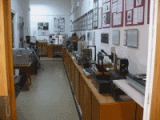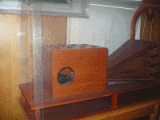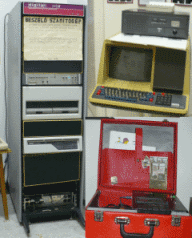An exhibition on the equipments used in experimental phonetics was funded in 2000. The exhibition is not available at the very moment due to reconstructions, but we hope to reopen it shortly after moving back to the Institute’s builing.
The aim is to introduce the equipments, tools and methods of speech research from the mechanic speaking machine by Kempelen to the present days. The handling of the speaking machine and the usage of the instruments can be experienced, as well. The description and specificities of the instruments can be read on pageants both in Hungarian and English. The exposed machines served several research projects of great value during the past decades.
Hungarian speech research had a twofold goal from the very beginning: to widen theoretical knowledge, and to work out the applications. Wolfgang von Kempelen built a speaking machine more than 200 years ago, in the 18th century, with what words and short sentences tly with other disciplines, like otology, in any language could be produced without human articulation. This innovation of Kempelen opened the horizon of human-machine communication. Hungarian speech research has been developing joinlaryngology, speech therapy, surdopedagogy, physics, engineering.
At the end of the 19th and at the beginning of the 20th century, phoneticians worked with equipments they had developed by themselves. Many of them have been preserved only by their descriptions in their writings. For example, the early version of palatography is exhibited that served to visualize the articulation by print on the palate and on the tongue.
At the beginning of the 20th century, correction of speech errors and teaching foreign language pronunciation were thought to be solved by the first results of the experimental speech research. Although these expectations did not come true, the discipline itself started an unbelievable development.
The appearance of speech recording, the mechanical and electronic instruments, visible speech, the spectrography and the computers led to the possibility of gaining more and more knowledge about human speech. One of the greatest results of the Department at the 70s was the real-time speech synthesis. This way we arrived after 200 years again at the human-machine communication at a more sophisticated level.
The exhibition introduces the first computer of the Department (PDP 11/34) that served speech
research including speech synthesis. There are instruments that were developed with the application of speech synthesis and some of them have been applied in practice (e.g., synthesized word test for childrens speech hearing evaluation).
This unique exhibition introduces curiosities, the appropriate operation of many of them is known only by a few people nowadays.
Papers on the exhibition:
- Gósy, M.: From Stomatoscopy to BEA: The History of Hungarian Experimental Phonetics. Proceedings of 17th ICPhS. Hong Kong, 2011. 172-175. Download
- Nikléczy Péter, Olaszy Gábor: Kempelen Farkas beszélőgépének rekonstrukciója. Beszédkutatás 2002. 5-17. Download
Some pictures on the exhibition






